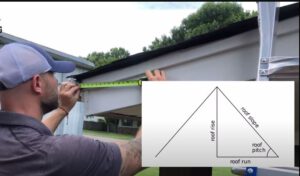 Choosing the right roof pitch is a crucial aspect of designing or renovating your Australian home. The pitch of your roof can significantly impact the aesthetic appeal, durability, and practicality of your home. But what factors should you consider, and how do these factors apply to the Australian context? Here’s a comprehensive guide to help you decide.
Choosing the right roof pitch is a crucial aspect of designing or renovating your Australian home. The pitch of your roof can significantly impact the aesthetic appeal, durability, and practicality of your home. But what factors should you consider, and how do these factors apply to the Australian context? Here’s a comprehensive guide to help you decide.
Understanding Roof Pitch
Roof pitch, or slope, refers to the steepness or incline of your roof. It’s generally expressed as a ratio of the vertical height (rise) to the horizontal distance (run), typically in the format of X:Y where X is the rise and Y is the run.
The Importance of Roof Pitch
Roof pitch is not just an architectural design element but also has practical implications. It can affect:
- How well your roof sheds rain and debris: A steep roof pitch means that water and debris can run off more quickly.
- The longevity of your roof: With a steep roof pitch, it’s harder for rain to seep in through the shingles or tiles, which can extend the life of your roof
- How easily you can access your gutters and other elements of the roof: A steeper roof can be more difficult to access for maintenance or repairs.
- The internal space and potential for attic conversion: A steeper roof can give you more internal space, which could be used for an attic conversion or storage.
The aesthetics of your home: Different roof pitches can create different ‘looks’ and styles to the exterior of a house.
Factors to Consider When Choosing Roof Pitch
Climate
In Australia, the climate varies significantly across regions, and it’s one of the main factors influencing the choice of roof pitch.
For areas with high rainfall, a steeper pitch can be beneficial as it allows rainwater to drain off more quickly, reducing the risk of water ingress and potential damage. Similarly, in snow-prone regions like the Australian Alps, a steeper pitch helps shed snow, preventing build-up that could lead to roof damage.
Conversely, in drier areas or regions with high winds, a lower pitch could be preferable. Lower pitched roofs offer less resistance to wind, reducing the potential for wind damage.
Design and Aesthetic
Your choice of roof pitch can have a substantial impact on the overall aesthetic and design of your home. Steeper pitches can lend a traditional, classic look to your home, while lower pitches generally give a modern, minimalist appeal. Ensure the roof pitch complements the architectural style of your home and fits into the broader neighbourhood aesthetics.
Building Regulations and Guidelines
 Local building codes, council regulations, and neighborhood guidelines can also influence your choice of roof pitch. These rules often specify minimum and maximum roof pitches for different types of roofing materials and styles. Ensure you’re familiar with these guidelines before deciding on your roof pitch.
Local building codes, council regulations, and neighborhood guidelines can also influence your choice of roof pitch. These rules often specify minimum and maximum roof pitches for different types of roofing materials and styles. Ensure you’re familiar with these guidelines before deciding on your roof pitch.
Roofing Material
The roofing material you choose can determine the minimum and maximum pitch you can have for your roof. For example, materials like slate and tiles typically require a steeper pitch, while metal roofing can be installed at a lower pitch.
Internal Space
The pitch of your roof impacts the internal space of your home. A higher pitched roof could provide additional space for an attic or loft conversion, offering added utility.
Cost
Finally, cost is an important consideration. Higher pitched roofs require more materials and can be more labor-intensive to install, thus potentially costing more.
Working with Roofing Professionals
Given the complexity of choosing the right roof pitch, it can be beneficial to engage professionals. Architects, designers, and roofing contractors bring expert knowledge about design aesthetics, material suitability, and local regulations, providing invaluable advice tailored to your specific circumstances.
In conclusion, the choice of the right roof pitch for your Australian home is a multifaceted decision, dependent on various factors. By considering your local climate, desired aesthetic, local regulations, chosen roofing material, space needs, and budget, you can make an informed choice that enhances the appeal, durability, and practicality of your home. Remember, collaboration with roofing professionals can greatly assist in this process, helping you achieve the optimal solution for your unique needs.
